February 8th Scots Book of Days
February 8 – 1306 Robert VI the Bruce, 6th Lord of Annandale, Earl of Carrick (1253–1304) widow Eleanor remarries, before February 8, 1306 (as his 1st wife) Richard Waleys, Lord Waleys, and they had issue. She died shortly before 8 September 1331.
 Bruce Motto: FUIMUS.
[from Latin: “We have been”]. Badge: rosemary Chief: Andrew Douglas Alexander Thomas Bruce, 11th Earl of Elgin Seat: Broomhall, Dunfermline. Crest: A lion stantan Azure armed and langued Gules
Bruce Motto: FUIMUS.
[from Latin: “We have been”]. Badge: rosemary Chief: Andrew Douglas Alexander Thomas Bruce, 11th Earl of Elgin Seat: Broomhall, Dunfermline. Crest: A lion stantan Azure armed and langued Gules
Brus or Bruce 1050 2Stewart2 Kennedy 2 Montgomery2 Blair2 Cochrane2 Miller 2 Simmons2 Choate2 Isaac ToaG
1546 Instrument of sasine. Laird of Garlies. One of 24 Lords of the Congregation. Sir Alexander Stewart, 4th of Garlies1 M, #299348, b. circa 1507, d. January 1580. Sir Alexander was the son of Sir Alexander Stewart, 3rd of Garlies and Dalswinton and Elizabeth Kennedy. Sir Alexander married, secondly, Margaret Dunbar, daughter of Sir Patrick Dunbar of Clugston. Sir Alexander married, thirdly, Katherine Stewart, daughter of Walter Stewart of Barclye. He married, firstly, Katherine Crichton, daughter of Sir James Crichton of Cranstounriddel, circa 1521.
Crichton of Brunstone 1100 2Gordon2 Kennedy2 Stewart2 Miller 2 Simmons2 Choate2 Jacob
Sir Alexander died in January 1580. Sir Alexander fought in the Battle of Solway Moss in November 1542, where he was captured by the English. In 1543 he was released in exchange for his son as hostage. On February 8, 1546, Alexander Stewart of Garroles younger witnessed Instrument of sasine for Alexander Adair N.P. and John Lokart chaplain (clan Lockhart) and 5 others of lands for William Carnis and Margaret McCulloch. Book “Wigtownshire Charters” Third Series, Edited by R.C.Reid, LL.D. Vol. LI (51) also notes Garlies / Garroles, of Alexander Stewart, younger, who was probably residing at Clary / Clarie Castle, home of the Bishops of Galloway :
Child of Sir Alexander Stewart, 4th of Garlies Marion Stewart
Children of Sir Alexander Stewart, 4th of Garlies and Katherine Stewart Robert Stewart, William Stewart, Helen Stewart
Children of Sir Alexander Stewart, 4th of Garlies and Margaret Dunbar – Sir Alexander Stewart of Garlies d. 1571, John Stewart d. 10 Aug 1592, Margaret Stewart
Citations Charles Mosley, editor, Burke’s Peerage, Baronetage & Knightage, 107th edition, 3 volumes (Wilmington, Delaware, U.S.A.: Burke’s Peerage (Genealogical Books) Ltd, 2003), volume 2, page 1511, 1512, 1881. Hereinafter cited as Burke’s Peerage and Baronetage, 107th edition.
Peter Beauclerk Dewar, editor, Burkes Landed Gentry of Great Britain – The Kingdon in Scotland, 19th ed. – volume 1 (Wilmington, Delaware, USA: Burke’s Peerage and Gentry LLC, 2001). Hereinafter cited as Burkes Landed Gentry, 19th ed.
1555 Lawrence Saunders, preacher, rector of London church of All Hallows – burned at Coventry, 8 February 1555. First four. Listed by Fox, Popularly called The Book of Martyrs, actual title “Actes and Monuments of these latter and perilous days, touching matters of the Church, wherein are comprehended and described the great persecutions and horrible troubles that have been wrought and practised by the Romish prelates, specially in this realm of England and Scotland, from the year of our Lord 1000 unto the time now present; gathered and collected according to the true copies and writings certificatory, as well of the parties themselves that suffered, as also out of the bishops’ registers, which were the doers thereof; by John Foxe.”
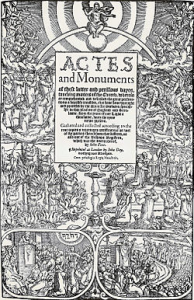 Title page of the first English-language edition, 1563.
Title page of the first English-language edition, 1563.
1586 Stewart Mary Queen of Scots age 44, executed at Fotheringhay Castle, Northamptonshire TG 33-184, Babington Plot to murder her cousin, Queen Elizabeth I. Scott and Wikipedia give the year as 1587, but notes Mary was arrested the previous August 11, 1586. As both England and Scotland were on the March 25th to March 24th calendar year, it would still be 1586 in February.
 Mary, Queen of Scots, Mary of Guise’s daughter, to whom she acted as regent from 1554 to 1560
Mary, Queen of Scots, Mary of Guise’s daughter, to whom she acted as regent from 1554 to 1560
 The execution of Mary Queen of Scots.
The execution of Mary Queen of Scots.
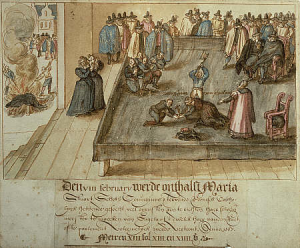 The Execution of Mary, Queen of Scots, 1542 – 1586, on 8 February 1586 (1586 in England and Scotland, the year 1586 would end March 24, the next day March 25 begins 1587) at Fotheringhay Castle, in Northamptonshire. After nineteen years in captivity, Mary was guilty of plotting the assassination of her cousin, Queen Elizabeth [1st from 1953]. This watercolour was made (1613. Artist unknown) for a Dutch magistrate who compiled an album of historical prints and drawings in 1613. Not surprisingly, the costume and architecture look very Dutch, but the picture does reflect eye witness accounts of the event. Mary’s clothes were burnt to prevent supporters keeping them as relics, and this scene is shown on the far left. www.nationalgalleries.org
The Execution of Mary, Queen of Scots, 1542 – 1586, on 8 February 1586 (1586 in England and Scotland, the year 1586 would end March 24, the next day March 25 begins 1587) at Fotheringhay Castle, in Northamptonshire. After nineteen years in captivity, Mary was guilty of plotting the assassination of her cousin, Queen Elizabeth [1st from 1953]. This watercolour was made (1613. Artist unknown) for a Dutch magistrate who compiled an album of historical prints and drawings in 1613. Not surprisingly, the costume and architecture look very Dutch, but the picture does reflect eye witness accounts of the event. Mary’s clothes were burnt to prevent supporters keeping them as relics, and this scene is shown on the far left. www.nationalgalleries.org
Mary is executed by Elizabeth – 1586 (often written as 1587, but the year had not changed). After being the focus of several plots to overthrow Elizabeth the Babington Plot of 1586 proved fatal for Mary. In replying to the conspirators Mary had placed herself in grave danger. Mary’s letters were doctored to help uncover the identities of all the plotters. Mary was tried, found guilty and eventually executed at Fotheringhay Castle. Video: A history of Scotland: Project Britain.
http://www.bbc.co.uk/scotland/history/the_reformation/mary_is_executed_by_elizabeth_i/
1599 never happened in Scotland. Dating its years from the birth of Jesus Christ, so that ‘’ every nation, kindred, every ear shall hear, every knee shall bow, and every tongue shall confess, Jesus Christ is Lord,’’ thru computer software applications and aviation, the Christian calendar has been adopted world wide for the Musselmen of Islam, the Buddhist, Confucian, Hindu, nativist, Jew, agnostic, or atheist (Isaiah 45:23, 1 Kings 19:18, Philippians 2:11, Romans 14:11, confirmed in modern times Mosiah 16:1, 27:31; Doctrine and Covenants 76:110, 88:104.
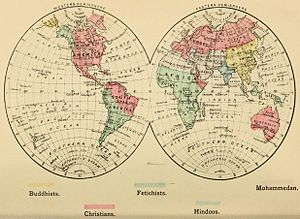 An 1883 map of the world divided into colors representing “Christians, Buddhists, Hindoos, Mohammedans, Fetichists”.
An 1883 map of the world divided into colors representing “Christians, Buddhists, Hindoos, Mohammedans, Fetichists”.
1601 – Robert Devereux, 2nd Earl of Essex, rebels against Queen Elizabeth – the revolt is crushed. Lord Lieutenant of Ireland in 1599 during The Nine Years War (1595–1603). Essex led the largest expeditionary force ever sent to Ireland — 16,000 troops — with orders to put an end to the rebellion. Essex fought a series of inconclusive engagements against O’Neill, wasted Essex’s funds, and dispersed Essex’s army into garrisons. To arm Irish soldiers, O’Neill bought muskets, ammunition and pikes from Scotland and England. From 1591 Scottish mercenaries were known as Redshanks. The Redshanks mostly came from the clans of MacLeod, MacQuarrie, MacLean, MacDonald, and Campbell.
 Macquarrie Badge: pine (Scots fir).
Macquarrie Badge: pine (Scots fir).
Campbell Earl of Argyll 1010 2Montgomery2Blair 2Cochrane2Miller 2Simmons2Choate to zoe TOAG
1693 – The College of William and Mary in Williamsburg, Virginia is granted a charter by King William III and Queen Mary II. (William was styled the 3rd in England after William the Conqueror and William Rufus, but was styled the 2nd in Scotland after William the Lion. Mary was styled the 2nd in England after Mary Tudor (‘bluidy Mary’) and so styled the 2nd in Scotland after Mary Stewart Queen of Scots. Same style, only different preceding monarchs, in each royal line. Another Mary, Queen Henrietta Maria to Charles 1st did not rule, although she was ancestor to William and Mary.)
1697 The Darien colony in the Isthmus between the Americas. Sometime in February. But as the menace of the envoy showed that the Darien Company must be thwarted in all its proceedings by the superior power of England, the prudent Hamburghers, ceasing to consider it as a hopeful speculation, finally withdrew their subscriptions. The Dutch, to whom King William III, could more decidedly dictate, from his authority as Stadtholder, and who were jealous, besides, of the interference of the Scots with their own East Indian trade, adopted a similar course, without remonstrance. Thus, the projected Company, deserted both by foreign and English associates, were crippled in their undertaking, and left to their own limited resources.
In like manner, in 1996, an attempt to do clinical trials to test sufferers of carpal tunnel syndrome and their use of the QWERTY keyboard layout, was rebuffed by the largest workers’ compensation carrier’s ergonomic engineers. The engineers were advised by the attorneys for Liberty Mutual not to fund any tests of keyboards due to massive liability exposure.
1751 did not occur in England, Ireland, British North America, and British colonies, as 1751 only had 282 days due to the Calendar Act of 1750. But 1751 did occur in Scotland, as 1751 had 365 days. Most branches of the Eastern Orthodox Church still use the repealed Julian calendar for calculating the dates of moveable feasts, including Easter (Pascha).
1807 Russians at the battle of Eylau against French. Tytler’s Britannica.
1915 release of Birth of a Nation is a fictionalized account of 3 books about the pre civil war (ante bellum), American civil war, and post civil war in South Carolina. Sometime in the movie after the Appamatox surrender, the slides describe the Scottish tradition of the fiery cross for a fictionalized KKK (which never used a fiery cross). The movie cross is the form of a crucifix, whereas the Scots would use the Andrews Cross for the fiery cross.
The last time recorded by the Scots using the fiery cross was in 1715, as noted by Sir Walter Scott about 1828. ‘On this raising of the clans in the year 1715, the fiery cross was sent through the districts or countries, as they are termed, inhabited by the different tribes. This emblem consisted of two branches of wood, in the form of a cross, one end singed with fire, and the other stained with blood. The inhabitants transmitted the signal from house to house with all possible speed, and the symbol implied, that those who should not appear at a rendezvous which was named, when the cross was presented, should suffer the extremities of fire and sword.’
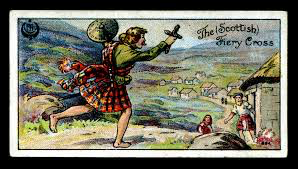 Typhoo Tea “Ancient & Annual Customs (series of 25 issued in 1922) #18 The Scottish Fiery Cross ~ as used by Highland Chieftans to summon the Clan.
Typhoo Tea “Ancient & Annual Customs (series of 25 issued in 1922) #18 The Scottish Fiery Cross ~ as used by Highland Chieftans to summon the Clan.
1942 January 27 – February 8, 1942 HM Queen Mary, Cunard Line, built Clydebank Scotland, converted to troopship. Hull damaged while entering dry dock in Boston Naval Shipyard. Troop capacity increased.
Utah Standard News depends on the support of readers like you.
Good Journalism requires time, expertise, passion and money. We know you appreciate the coverage here. Please help us to continue as an alternative news website by becoming a subscriber or making a donation. To learn more about our subscription options or make a donation, click here.
To Advertise on UtahStandardNews.com, please contact us at: ed@utahstandardnews.com.


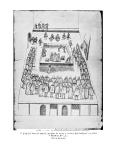
Comments - No Responses to “February 8th Scots Book of Days”
Sure is empty down here...